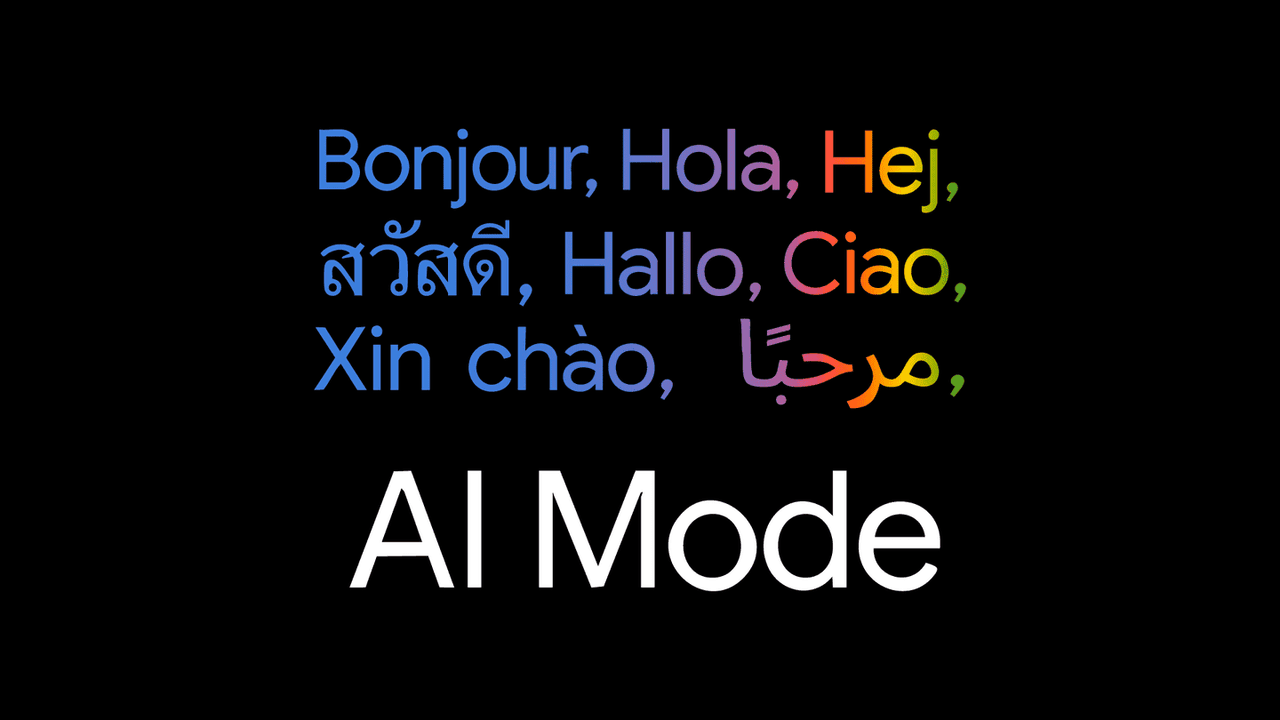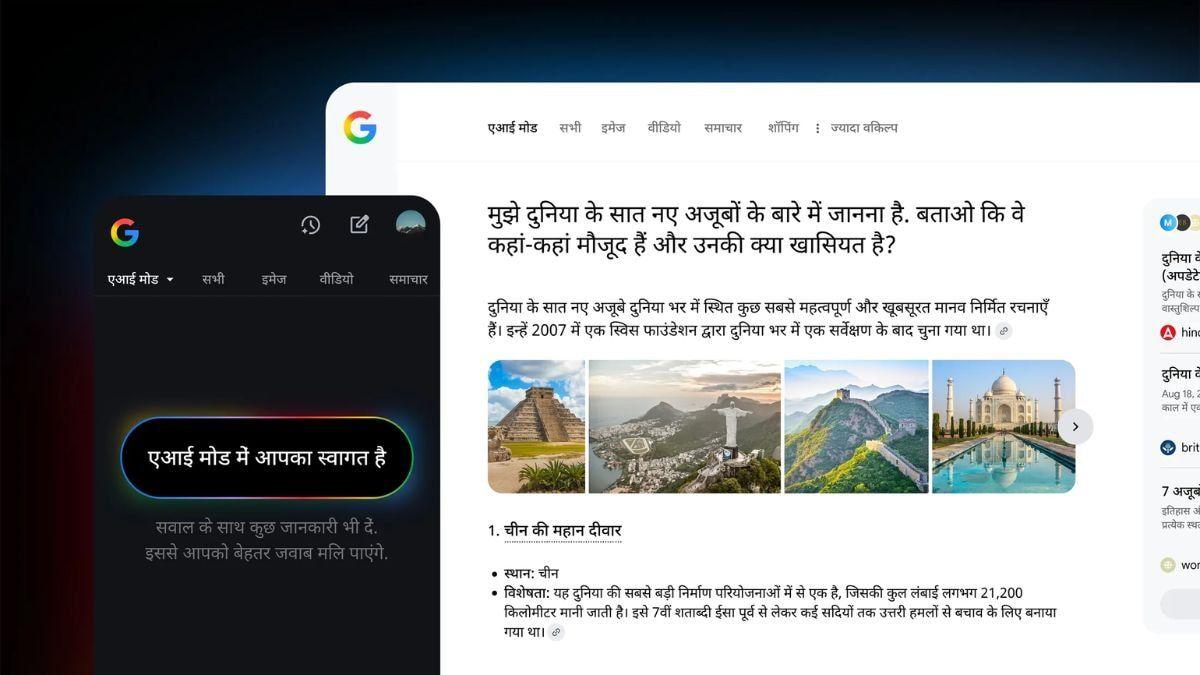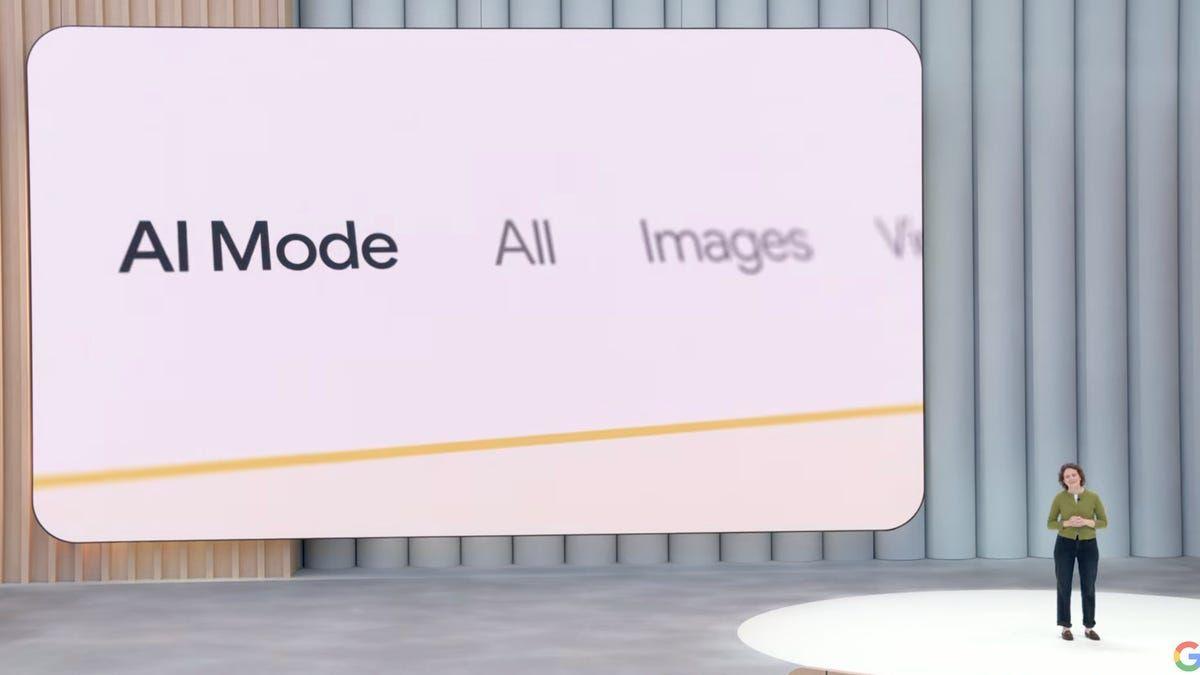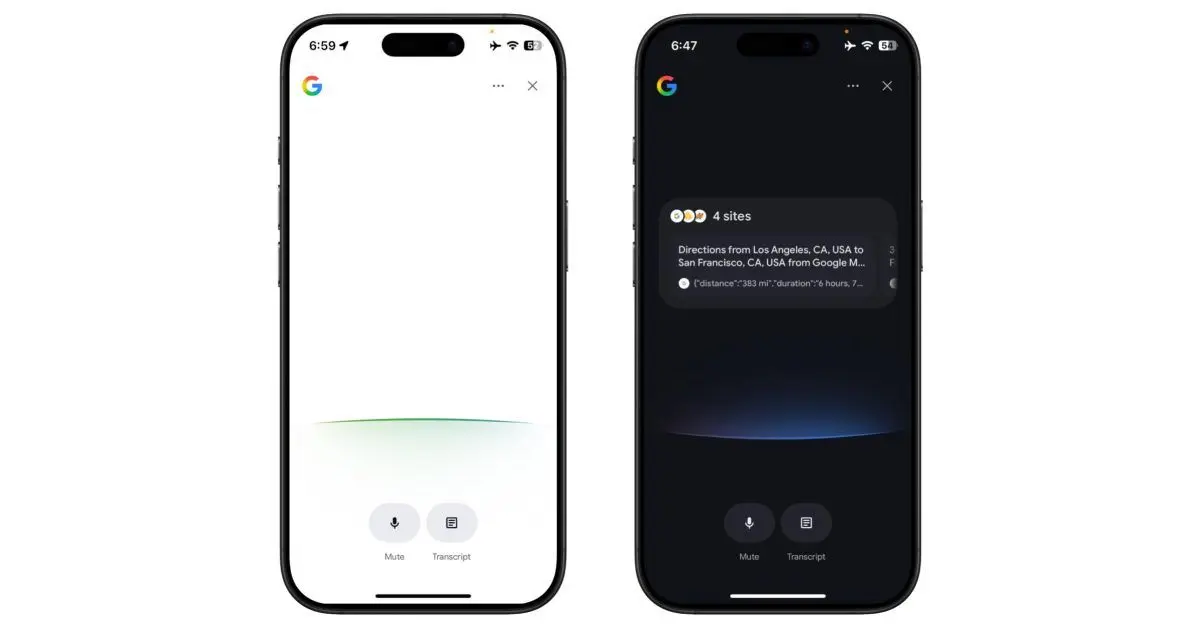Google Expands AI-Powered Search Globally with Multilingual Support
10 Sources
10 Sources
[1]
Google's Search Live comes to India, AI Mode gets more languages | TechCrunch
Google is bringing its AI-powered conversational search feature, Search Live, to India -- launching in English and Hindi -- and expanding AI Mode to seven new Indian languages, as the company strengthens its presence in one of its fastest-growing markets. First introduced in the U.S. in July, Search Live builds on Google's Project Astra technology and is available through the company's AI Mode. The feature lets users point their phone camera at objects to get real-time assistance, supporting back-and-forth conversations that draw on the visual context from the camera feed. With this launch, India becomes the second market after the U.S. to get Search Live -- a logical move given the country's vast base of early AI adopters, who have helped Google grow products like Gemini's Nano Banana model. Google plans to leverage India's early adoption to train its systems on a wider range of visual contexts, making Search Live more capable over time. "People in India are power users of multimodal search, forming our largest user base for both voice and visual search globally," said Hema Budaraja, vice president of product management for Search at Google, in a new blog post. Search Live is starting to roll out to users in India today and will reach more people over the coming weeks. Once available, users can access it by tapping the "Live" icon under the search bar in the Google app, or by opening Lens and selecting "Live" from the bottom of the screen. Earlier this year, Google revealed that Search Live is powered by a custom version of Gemini. The Gemini app separately includes a similarly named feature called Gemini Live, which was introduced in May and offers a comparable experience. This overlap could easily confuse some users. Google has also expanded its AI Mode to seven Indian languages: Bengali, Kannada, Malayalam, Marathi, Tamil, Telugu, and Urdu. This is part of a global AI Mode expansion, which will be available in more than 35 new languages and 40 new countries and territories, making the AI-powered search experience accessible in over 200 countries and territories worldwide. Google's AI Mode, which debuted in the U.S. in March and rolled out to more U.S. users in May, lets users ask complex, multi-part questions through an AI-powered interface. It launched in India in June and expanded globally in August. Last month, Google added five new languages -- including Hindi, Indonesian, and Japanese -- to the feature. "The advanced reasoning and multimodal understanding of our custom Gemini model for Search allows AI Mode to truly grasp the subtleties of local languages, ensuring AI Mode is genuinely helpful and relevant in all the new languages we introduce," Budaraju said in his post. Google's AI Mode and other AI features, including AI Overviews, have faced criticism for reducing search traffic to online publishers. The company, however, has denied that its AI-driven search tools are hurting website visits.
[2]
Google Search AI Mode Now Available in 35 More Languages and 40 More Countries
Bengali, Malay, Persian? Check, check and check. Google has rolled out its AI mode for search to 40 more countries and 35 more languages, putting it within reach of millions worldwide. Don't miss any of our unbiased tech content and lab-based reviews. Add CNET as a preferred Google source. The rollout continues the rapid expansion of AI mode, which launched to US consumers on June 27 and is now offered in more than 200 countries and territories. Adding dozens of new languages shows how much more advanced the company's Gemini AI models have become, Hema Budaraju, vice president of Google Search product management, said in a blog post Tuesday. Gemini is "allowing people to ask anything on their mind in the way that's most natural to them, thanks to our natural language understanding and multimodal capabilities," Budaraju said. "Now, more people can ask anything in their preferred language." Budaraju said that AI mode can "truly grasp the subtleties of local languages" and that it will soon be added to more languages and regions. AI Mode allows users to answer questions ranging from simple ("When is daylight savings?") to complex ("What was the Great Depression?"). You can access it via a button on the right side of the search bar on the Google home page or on the left side of the menu toward the top of other Google pages. The direct URL is here. AI Mode consumers can use text, photos and videos in their queries. Users can upload a scenic image into AI Mode search and ask for a response that tells where the photo was taken. You can also receive images as your answers in AI Mode, for example, asking the chatbot to "show me photos of the most scenic places in Seattle." Google has also enhanced shopping searches in AI Mode, so users can ask, " Where can I buy comfy winter sweaters?" and get a list of retailers. AI Mode is powered by Gemini, which is Google's family of AI models and also the name of its chatbot. AI Mode is designed to synthesize the answers to user search questions in a conversational manner. Shortly after its launch in early summer, CNET broke it all down right here.
[3]
Google Search AI Mode is now available in more languages and regions
Google has been rapidly expanding the availability of AI Mode in Search ever since it previewed the feature with testers in its Labs program in the beginning of March this year. Now, the company has announced that it has started rolling out the dedicated AI chatbot within Search to 40 new regions and has made it available in 35 new languages. The newly supported languages include Arabic, Chinese, Croatian, Czech, Dutch, German, Greek, French, Malay, Russian, Thai, Vietnamese and more. Google says the advanced reasoning and multimodal understanding of its custom Gemini model for Search allow it to grasp the subtleties of local languages, so it doesn't misunderstand inquiries or generate stilted answers. In May, two months after Google started testing the feature, the company rolled it out to everyone in the US. At the time, it said that it will "graduate many features and capabilities from AI Mode right into the core search experience in AI Overviews" as it gets more feedback. In early September, Google opened up AI Mode to more languages, namely Hindi, Indonesian, Japanese, Korean and Brazilian Portuguese. More and more users in the new regions will see AI Mode responses in their Search page and will be able to interact with the feature in their preferred language over the coming weeks. The company plans to add more capabilities to AI Mode and recently released an update that made it better at understanding visual prompts. It's worth noting that, while AI Mode results could be useful for quick inquiries, online publishers attribute declining web traffic to the summaries. A Pew Research Center study found that users are less likely to click on website links and are more likely to end their browsing session if they see an AI Mode summary at the top of their results page.
[4]
Google unleashes AI Search globally in major expansion
Google's AI Mode in Search, which turns your web search into a back-and-forth conversation with Google's AI, is no longer limited to a select few. Google is rolling out AI Mode to over 40 countries and territories and adding support for more than 35 new languages. At first, this feature was only available in a few places. Now, Google is expanding it to over 200 countries, making it one of the biggest rollouts so far. Powered by Gemini models, the tool gives users a more natural and conversational search experience. It goes beyond just matching keywords and aims to understand what people really mean. AI Mode lets people ask more detailed and complex questions, not just basic ones. For example, instead of searching for 'best places to visit in Tokyo,' someone might ask, 'Where should I go in Tokyo if I love local food and hidden cultural spots?' The system can pick up on these details, look at different aspects of the question, and give thorough answers right in Search. Google has noticed that people are already starting to type longer and more specific questions. Speaking your language, literally and culturally Additionally, language support now covers a wide range of additions such as Arabic, Chinese (Simplified and Traditional), Dutch, French, German, Hindi, Italian, Japanese, Korean, Portuguese, Spanish, and many others. This is on top of last month's expansion. The rollout is already live for many users and will continue over the next week, as per Google's announcement. Under the hood, Gemini models power most of the new features and help Google Search understand not only text but also images. The models also make it easier for Search to pick up on local context, slang, and common phrases, which is important in places where translations can miss cultural details. Google says this smarter approach helps give more accurate and useful results, no matter where you are or what language you use.
[5]
Google Search flips the AI switch for millions more users
More languages, more countries. Here's how to check availability and turn it on today What's happened? Google is lighting up AI Mode in Search for a lot more people, starting today. The rollout adds support for more than 35 new languages and 40-plus new countries and territories, pushing availability past 200 countries worldwide. It is powered by the latest Gemini models, which handle natural language and visuals. Wider rollout begins this week. Google says its custom Gemini model for Search brings stronger reasoning and multimodal understanding, which helps it grasp local phrasing and context instead of just matching keywords. Early usage signals a behavior shift, with users asking questions nearly three times longer than traditional searches, and Google expects that trend to grow as more regions come online. This is important because: AI Mode is changing how people search, not just where it is available. Longer, conversational queries mean you can describe the problem in your own words and still get a useful answer. With Gemini handling language and visuals, Search becomes like an assistant. It lowers the barrier for non-English speakers. Multimodal understanding means you can combine different input like text and images. It can help with real-world tasks, like asking "what plant is this" to troubleshooting a gadget with a photo. Longer queries or questions tend to make AI understand intent with context, so answers can be more direct, saving you from switching tabs and tutorials. Recommended Videos Why should I care? Instead of wasting time chopping questions into keywords, you can just talk in your language and get a clear answer that blends text, images, and context. It's faster with less guesswork. You'll spend less time bouncing switching tabs, since AI Mode can summarize options, pull steps, and point you to the right direction. It's great for messy problems, trip planning, or home fixes, where you can add photos and follow-up questions to refine the result. Okay, so what's next? The rollout is staggered, so expect a quiet switch-on over the next week. You may see AI Mode appear in the Google app and mobile web, or desktop, depending on your region. To use AI mode on your phone, update to the latest version of the Google app and click on the breathing, colorful magnifying glass icon. On desktop, click the colorful AI mode button within the Google search bar, and ask away. AI mode is only as good as your curiosity, so treat it like a guide. You can ask follow-up questions or add a photo to see how far a better question can take you.
[6]
AI Mode is now available in more languages and locations around the world.
Starting today, we're bringing AI Mode in Google Search to more people around the world, launching in more than 35 new languages and over 40 new countries and territories. Now, AI Mode will be available in over 200 countries and territories total, including many across Europe. Our latest Gemini models are powering dramatically more powerful capabilities in Search, allowing people to ask anything on their mind in the way that's most natural to them, thanks to our natural language understanding and multimodal capabilities. Now, more people can ask anything in their preferred language. The advanced reasoning and multimodal understanding of our custom Gemini model for Search allows AI Mode to truly grasp the subtleties of local languages, ensuring AI Mode is genuinely helpful and relevant in all the new languages we introduce. With AI Mode, we're already seeing people diving deeper into complex topics and asking questions nearly three times longer than traditional searches. The experience will roll out to more people over the next week.
[7]
Google's AI Mode Search Expands to Dozens of Countries Worldwide - Phandroid
Google rolled out its AI Mode search experience to users in dozens of countries worldwide. The expansion brings AI-powered search responses to regions across the Americas, Asia-Pacific, Europe, the Middle East, and Africa. For those unfamiliar, AI Mode transforms how people interact with Google Search. Instead of just scanning through links, users can ask questions using text, voice, or images and get comprehensive answers with advanced reasoning. The AI can handle follow-up questions too, making search feel more like a conversation than a keyword hunt. This is basically Google's answer to Perplexity. The geographic reach is commendable. In the Americas, AI Mode is now available in the United States, Canada, Mexico, Brazil, Argentina, and several Caribbean and Central American countries. The Asia-Pacific rollout includes Australia, India, Japan, Malaysia, South Korea, Singapore, Thailand, Indonesia, Vietnam, and various Pacific islands. European users in the UK, Germany, France, Spain, and Italy can access it, along with people in the Middle East and Africa, including South Africa, Israel, UAE, and Saudi Arabia. Language support is equally broad. AI Mode works in English, Spanish, French, German, Chinese (both Simplified and Traditional), Arabic, Hindi, Korean, Vietnamese, Portuguese, and more. This makes the feature accessible to users in their native languages rather than forcing everyone to search in English. Getting started is simple. You can access AI Mode directly at google.com/ai, or find it on the Google homepage and mobile app where an AI Mode option appears. The feature is available to users 18 and older. For better personalization, Google recommends opting into search history and personalization settings. However, there is the question of how this will affect publishers who typically rely on clicks for ad revenue and traffic. There have been accusations that this has caused a dip in traffic, but Google has begged to differ.
[8]
Google's Search Live in AI Mode Launched in India: See Supported Languages
AI Mode is expanding to seven new Indian languages, Google said Google on Wednesday announced the rollout of the Search Live in AI Mode feature in India. It allows users to ask questions about their surroundings using the phone camera and have voice-based conversations with the artificial intelligence (AI). The move was first announced by the Mountain View, California-based tech giant last month. Alongside, Google has also signalled the expansion of AI Mode to seven new Indian languages, including Bengali, Kannada, and Telugu. Search Live in AI Mode Works in English and Hindi Search Live in AI Mode has been limited to the US since its introduction in July 2025. The two-way conversation feature has not been expanded to any other country or language apart from English until now. Google, in a blog post, said that it is rolling out in India, making it the first country outside the US to receive the feature. As per the company, it will be available in both English and Hindi, enabling users in the region to have voice conversations with the AI chatbot. They can also share their camera feed with the Google app to ask specific questions about their surroundings and receive responses, leveraging the capabilities of Google Lens. Last month, Google announced that it had decided to bring Search Live in AI Mode to India after witnessing high usage of AI Mode among users in the country. Apart from this, the company is also expanding AI Mode to more languages in India. It will now be available in Bengali, Kannada, Malayalam, Marathi, Tamil, Telugu, and Urdu. The feature was previously only available in English and Hindi. Search Live in AI Mode, notably, uses a custom version of Gemini that has advanced voice capabilities. It leverages a query fan-out technique where they are broken down into subtopics. The AI model then runs multiple, simultaneous searches for each of them. Solving queries in Search Live is as simple as pointing the phone's camera at an object and asking questions about it. Users can also ask follow-up questions, and the AI will respond in real time. Alongside responses, Google also provides easy-to-access links on the screen, if they wish to further explore the topic.
[9]
Google's Search Live Arrives in India: AI Mode Now Available in 7 New Indian Languages!
India became the second country, after the US, to receive this feature. Supported by an AI-powered feature, users can engage in a conversation with Google Search using their phone's camera and microphone. Launched in the US in July, Search Live is supported by Google's Project Astra technology, which is available through the company's AI Mode. The Search Live feature allows users to point their phone's camera at objects to receive real-time assistance. Additionally, it supports back-and-forth conversations that draw on the visual context from the camera feed. Search Live conducts real-time conversations and provides up-to-date information from the web simultaneously. "People in India are power users of multimodal , forming our largest user base for both voice and visual search globally," said Hema Budaraju, vice president of product management for Search at Google, in a new blog post. "The advanced reasoning and multimodal understanding of our custom Gemini Live for Search allows AI Mode to truly grasp the subtleties of local languages, ensuring AI Mode is genuinely helpful and relevant in all the new languages we introduce," Budaraju said in the post. In an example shared by Google, a user trying to perfect an iced matcha at home asks Search Live about the order in which to combine various ingredients and gets an instant response from the chatbot.
[10]
How to disable or enable Search Live in Google AI Mode on your phone
India is the first country outside the US to get this experience. Google has announced a major update to its search features in India. With the new Search Live in AI Mode, users can now have real-time, interactive conversations with Google using voice and camera. This update is part of Google's effort to make searching more intuitive, conversational, and accessible for everyone. India is the first country outside the US to get this experience, available in both English and Hindi. Here's everything you need to know about the Search Live feature. Search Live is a way to interact with Google. Instead of typing out your queries, you can talk to Search and show it what you see using your phone's camera. Google will respond with helpful AI-generated audio answers, and you can continue the conversation with follow-up questions. Whether you're trying to cook a new recipe, fix something at home, complete schoolwork, or explore a new place, Search Live makes it easier to get instant guidance. The conversation stays active in the background, so you can continue using other apps while interacting with Google. You can also revisit past responses anytime through your AI Mode history. Also read: OnePlus 13s available with over Rs 7,000 discount during Amazon Great Indian Festival 2025 Using Search Live on your phone is simple: You can switch from AI Mode to a Live conversation at any time by tapping the Live icon. You can also start a Search Live chat with your camera directly from Google Lens by tapping Live. You can disable Search Live by disabling the AI Mode, and in order to do so, you can visit labs.google.com/search.
Share
Share
Copy Link
Google's AI Mode in Search, powered by Gemini models, is now available in over 200 countries and supports 35 new languages. This expansion marks a significant step in making AI-assisted search more accessible worldwide.
Global Expansion of Google's AI-Powered Search
Google has significantly expanded the availability of its AI Mode in Search, bringing the feature to over 200 countries and territories worldwide. This expansion includes support for more than 35 new languages, making the AI-powered search experience accessible to millions of users across the globe
1
2
3
4
5
.Multilingual Support and Cultural Understanding
The newly supported languages include Arabic, Chinese (Simplified and Traditional), Dutch, French, German, Hindi, Italian, Japanese, Korean, Portuguese, Spanish, and many others
4
. Google's custom Gemini model for Search allows AI Mode to grasp the subtleties of local languages, ensuring that the feature is genuinely helpful and relevant in all the new languages introduced1
.
Source: Google
Enhanced Search Capabilities
AI Mode transforms traditional web searches into conversational interactions, allowing users to ask complex, multi-part questions through an AI-powered interface
1
. The system can understand and respond to more detailed and specific queries, going beyond simple keyword matching4
.
Source: Engadget
Multimodal Understanding and Visual Search
Google's AI Mode leverages advanced reasoning and multimodal understanding, enabling users to combine text, photos, and videos in their queries
2
. This feature allows for more interactive and context-rich search experiences, such as uploading images to identify locations or objects2
3
.Search Live in India
As part of this expansion, Google is introducing Search Live in India, available in English and Hindi
1
. This feature builds on Google's Project Astra technology and allows users to point their phone cameras at objects for real-time assistance, supporting back-and-forth conversations based on the visual context1
.
Source: Gadgets 360
Related Stories
Impact on User Behavior
Early usage data suggests a shift in search behavior, with users asking questions nearly three times longer than traditional searches
5
. This trend is expected to grow as more regions gain access to AI Mode, potentially changing how people interact with search engines5
.Concerns and Criticisms
While the expansion of AI Mode offers enhanced search capabilities, it has faced criticism for potentially reducing search traffic to online publishers
1
. A Pew Research Center study found that users are less likely to click on website links when AI Mode summaries are present, which could impact web traffic for content creators3
.Future Developments
Google plans to continue adding more capabilities to AI Mode and has recently released an update improving its understanding of visual prompts
3
. The company aims to leverage early adoption in markets like India to train its systems on a wider range of visual contexts, making Search Live more capable over time1
.References
Summarized by
Navi
[4]
[5]
Related Stories
Google Launches Search Live: AI-Powered Real-Time Video Search for US Users
24 Sept 2025•Technology

Google Expands AI-Powered Search to India: A New Era of Complex Queries and Multimodal Interactions
24 Jun 2025•Technology

Google's AI Mode: Revolutionizing Search with Advanced AI Integration
02 Jul 2025•Technology

Recent Highlights
1
Google launches Gemini 3 Flash as default AI model, delivering speed with Pro-grade reasoning
Technology

2
OpenAI launches GPT Image 1.5 as AI image generator war with Google intensifies
Technology

3
OpenAI launches ChatGPT app store, opening doors for third-party developers to build AI-powered apps
Technology





